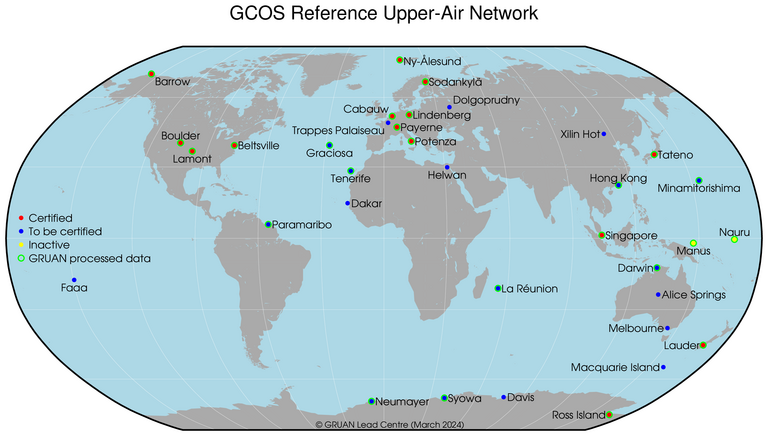
Figure: GRUAN Stations as of 2024
The GCOS (Global Climate Observing System) Reference Upper-Air Network (GRUAN) was founded in 2008 as an international reference-observing network, designed to fill an important gap in the current global observing system. GRUAN measurements provide long-term, high-quality climate data records from the surface, through the troposphere, and into the stratosphere. These are used to determine trends, constrain and calibrate data from more spatially comprehensive observing systems (including satellites and current radiosonde networks), and provide appropriate data for studying atmospheric processes.
GRUAN, to the extent possible, builds on existing observational networks and capabilities, including those of NDACC. It currently consists of 33 selected sites in various climate zones, and is represented with at least one site on each continent. The aim is to establish additional sites in Africa, South America and the central Pacific.
Essential criteria for a GRUAN reference observation include measurement-traceability (to SI units or equivalent standards), correction of all known errors and biases, and the availability of measurement uncertainties. The transparent, well documented, data processing is applied to raw measurement data, using correction methods that are based on extensive characterisation of the instrument and its sensors, yielding a GRUAN data product (GDP) that is devoid of manufacturer-dependent artifacts. Currently, GDPs have been developed for radiosondes (Meisei RS-11G, Meisei iMS-100, Vaisala RS92, Vaisala RS41) and for GNSS-PW, with under development the GDP for lidar profiles of temperature and water vapor and for the water vapour concentration profile in the stratosphere, measured using all available instruments (Meisei SKYDEW, CFH, FPH).
GRUAN is governed by the Working Group on GRUAN, supported by the Lead Centre. A periodically reviewed implementation plan guides the activities of the Working Group. The GRUAN Lead Centre is hosted by Lindenberg Meteorological Observatory of Deutscher Wetterdienst (DWD). The Lead Centre takes care of the daily management and the coordination of the network, which includes data management (archiving and processing) communication with sites, reporting, issuing guidelines, publishing technical documentation and maintaining the GRUAN website.
Task teams on radiosondes, GNSS precipitable water, ground-based remote sensing, satellite-based remote sensing measurements, and site representation further support the Working Group and Lead Centre. Formal GRUAN operating procedures, including formal site assessment and certification, are documented in the GRUAN Manual and Guide.GRUAN reports to the GCOS Atmospheric Observation Panel for Climate (AOPC), and cooperates closely with relevant committees of the World Meteorological Organization (WMO), such as the Commission for Observation, Infrastructure and Information Systems (INFCOM) and the Standing Committee on Earth Observing Systems and Monitoring Networks (SC-ON).
Last revision: October 2024